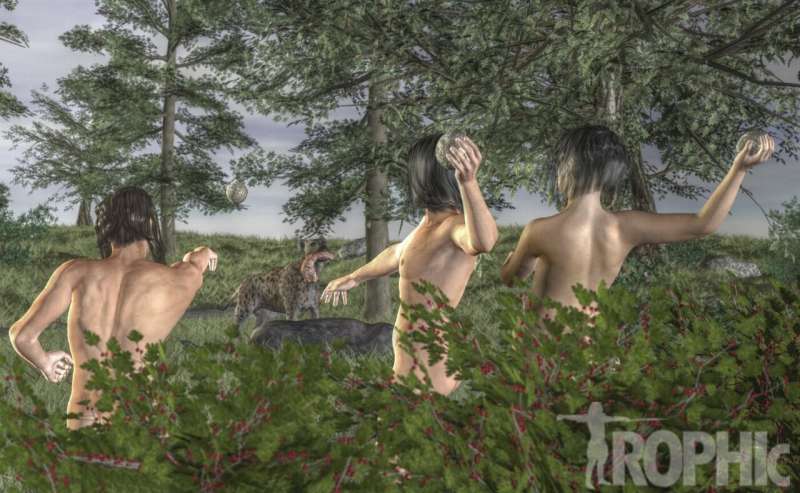This article has been reviewed according to Science X's editorial process and policies. Editors have highlighted the following attributes while ensuring the content's credibility:
fact-checked
peer-reviewed publication
trusted source
proofread
Human evolution: Hominins challenge giant hyenas for carcasses in Prehistoric simulations

Hominins—the group that includes humans and our extinct relatives—may have been capable of competing with giant hyenas for carcasses abandoned by saber-toothed cats and jaguars during the late-early Pleistocene era (approximately 1.2 to 0.8 million years ago) in southern Europe. The findings of this modeling study are published in Scientific Reports and suggest that moderately sized groups of hominins may have been the most successful at scavenging.
Previous research has theorized that the number of carcasses abandoned by saber-toothed cats may have been able to sustain early hominin populations in southern Europe. However, it has been unclear whether other large scavengers such as giant hyenas may have limited hominin access to this food resource.
Ana Mateos, Jesús Rodríguez, and colleagues ran simulations to model competition for carrion (the flesh of dead animals) between hominins and giant hyenas (Pachycrocuta brevirostris) in the Iberian Peninsula in the late-early Pleistocene era.
The authors simulated whether the saber-toothed cats Homotherium latidens and Megantereon whitei and the European jaguar (Panthera gombaszoegensis) could have left enough carrion to support hyena and hominin populations, and how this may have been affected by the size of scavenging groups of hominins.
The authors found that when hominins scavenged in groups that were large enough to chase away giant hyenas (five or more individuals), hominin populations exceeded giant hyena populations by the end of simulations. However, when hominins scavenged in very small groups, they were only able to survive to the end of a simulation when predator density—and therefore carcass availability—was high.
The simulations also suggested a potential optimum group size for scavenging hominins, as groups of over 10 individuals were able to chase away saber-toothed cats or jaguars but groups of over 13 individuals required more carcasses to sustain their energy expenditure. However, the authors note that their simulations could not specify what the optimum group size was as the numbers of hominins needed to chase away hyenas, saber-toothed cats, and jaguars were pre-determined and arbitrarily assigned.
Together, the findings suggest that moderately-sized groups of late-early Pleistocene hominins in southern Europe may have been able to regularly obtain food by scavenging for carcasses, even in competition with giant hyenas. The authors speculate that scavenged remains may have been an important source of meat and fat for hominins, especially in winter when plant resources were scarce.
More information: Ana Mateos, Computer simulation of scavenging by hominins and giant hyenas in the late Early Pleistocene, Scientific Reports (2023). DOI: 10.1038/s41598-023-39776-1. www.nature.com/articles/s41598-023-39776-1
Journal information: Scientific Reports
Provided by Nature Publishing Group




















